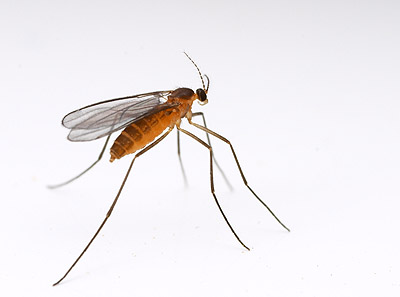Can't devote much to blogging at the moment, but since we're feeling sorry for the dipterists this week here's a fly for you to look at:

Gall Midge, Cecidomyiidae - California
Maybe one of you fly folks could explain in the comments why Cecidomyiids are so cool. Aside from looking like little fairies, that is.
photo details: Canon MP-E 65mm 1-5x macro lens on a Canon D60
ISO 100, f/13, 1/200 sec, flash diffused through tracing paper

I am not a Dipteirist and in general I don't know anything on flies, but I know at least one Cecidomyiid: Aphidoletes aphidimyza.
The larvae of this Diptera is able to make all its cycle inside ant attended aphids colony without been detected by the bodyguards(the ants). The larva feed on the aphids by paralyzing them right away after bitting which avoid them to release alarm pheromones. Also the larva of A. aphidimyza move inside the colony by very slow movements and this way not been detected by ants (which at the same time protect certainly them against their intraguild predator).
I though that for an orange larvae which look like nothing, that was pretty cool.
So what you're saying, Benoit, is that these flies are cool because they do something with ants.
Not that I disagree, of course, but that sort of puts us back in the "pity-the-poor-dipterist" zone.
Actually, my point is not about the ants here, but really about the flies.
My "deviance" comes from the fact that I was interested to them because of the ants. But the behavior of the flies by itself is just really cool, the ants in this case having only a second role. The Cecidomyid larvae have the first one by cheating in the ant-aphid (or aphid-ant if you prefer) system.
Other species of Cecidomyid have also really neat parasite life traits (and this time no ants at all around), but I don't remember what are the details to expose them here. Sorry ;)
I hope a Dipterist could refresh my memory and show us how cool they are!
By the way, it is a really neat pictures of such small creatures.
"but since weâre feeling sorry for the dipterists this week"... a bit patronizing, huh?! Only an ant person would think Cecidomyiidae are cool "because they look like fairies" :) I work on lower Diptera and I don't think they're that cool, but they do do a lot of things.As larvae they can feed on fungus and plants (making galls), can be predaceous (like Benoit said), or can be internal parasitoids (such as Endaphis which is an internal parasitoid of aphids). But the adults are pretty boring, except for some wierd chromosomal/genomic things and one genus Baeonotus which is neotenic. I'm sure there are even more interesting things but, like I said, I don't find them particularly interesting (that's just my opinion). They are also a pain to ID, especially without their diagnostic galls.I think other families of flies are just as interesting, especially ones in which both the adult and larval stages stages are interesting (Corethrellidae? Axymyiidae? Blephariceridae*?)*any family in which the larvae transfor into pupae in 5-10 minutes is cool, not tomention all of the other cool things about this family
Thanks Matt. Do you have any thoughts about where I could find Blepharicerids in Illinois? I knew places to get them in California, but the midwest is new territory for me.
I don't really know whether blephs can be found in IL - they prefer clean, swiftly flowing, rocky streams, usually at higher elevations. That being said, they may be there. I would contact Greg Courtney at Iowa State. He is the world expert on Blephariceridae and lives in the midwest, so he's probably collected in that area and would know where to go. But you might not want to get your hopes up :)